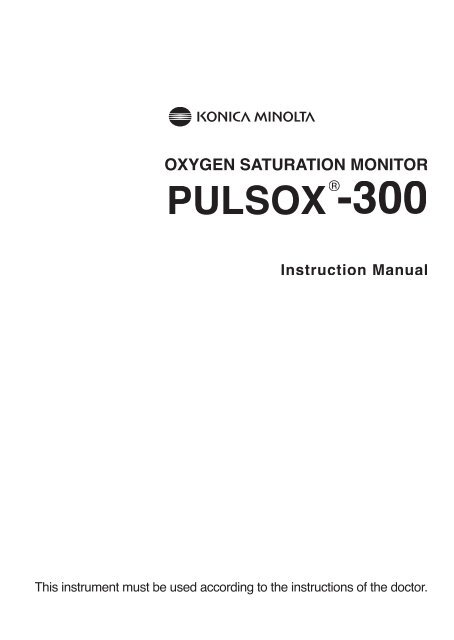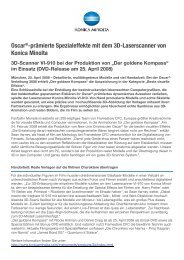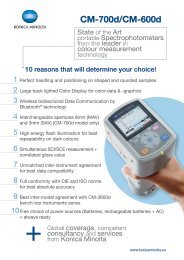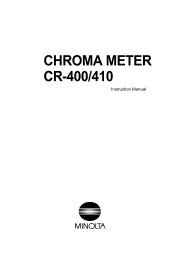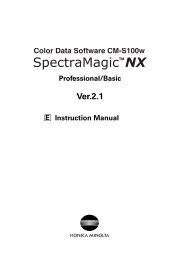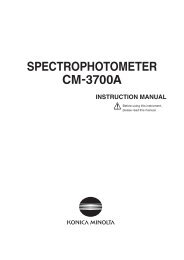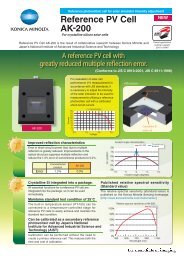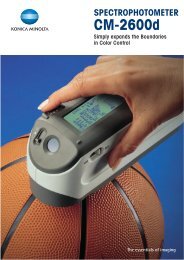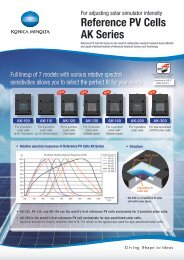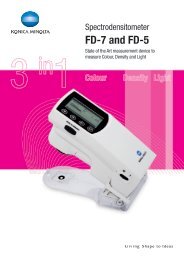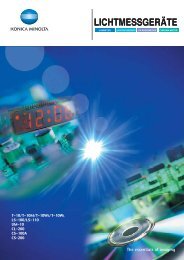Pulsox-300 Instruction Manual Download - KONICA MINOLTA ...
Pulsox-300 Instruction Manual Download - KONICA MINOLTA ...
Pulsox-300 Instruction Manual Download - KONICA MINOLTA ...
You also want an ePaper? Increase the reach of your titles
YUMPU automatically turns print PDFs into web optimized ePapers that Google loves.
OXYGEN SATURATION MONITOR<br />
®<br />
PULSOX -<strong>300</strong><br />
<strong>Instruction</strong> <strong>Manual</strong><br />
This instrument must be used according to the instructions of the doctor.
Safety Symbols<br />
Warnings and precautions noted in this manual and the instrument are indicated<br />
by the following markings, designed to prevent accidents caused by erroneous<br />
handling of the equipment.<br />
This indicates text consisting of a warning or precaution relating to safety.<br />
Please read the text carefully and use the equipment safely.<br />
This indicates an action which is prohibited.<br />
The prohibited action should never be carried out, under any circumstances.<br />
This indicates instructions concerning an action.<br />
Always follow the instructions carefully.<br />
This indicates an action which is prohibited.<br />
Never disassemble the product or unit.<br />
This symbol indicates that has no alarm function is prescribed in<br />
IEC60417-5319.<br />
This symbol indicates type BF equipment.<br />
The instrument provide a particular degree of protection against electric<br />
shock, particularly the leakage current and reliability of the protective<br />
earth connection with an F-TYPE APPLIED PART.<br />
F-TYPE APPLIED PART indicates applied part isolated from all other<br />
parts of the instrument to such a degree that the patient leakage current<br />
allowable in single fault condition is not exceeded when a voltage equal<br />
to 1.1 times the highest rated mains voltage is applied between the applied<br />
part and earth.<br />
This symbol indicates D.C.<br />
Authorized Standards<br />
For North America<br />
UL, C_ UL:<br />
For Europe<br />
CE (Medical Device Directive):<br />
WITH RESPECT TO ELECTRIC SHOCK, FIRE AND MECHAN-<br />
ICAL HAZARDS ONLY IN ACCORDANCE WITH UL 60601-1,<br />
CAN/CSA C22.2 No.601.1<br />
This instrument complies with EN60601-1, EN60601-1-2,<br />
EN14971, EN13485.
Safety Precautions<br />
To ensure correct use of this instrument, read the following points<br />
carefully and adhere to them. After you have read this manual,<br />
keep it in a safe place where it can be referred to anytime a<br />
question arises.<br />
WARNING<br />
(Failure to adhere to the following points may result in death or serious injury.)<br />
The instrument is designed for measurement of the oxygen<br />
saturation (SpO2) of arterial blood and the pulse<br />
rate. Do not use it for any other purposes, such as<br />
warning of sleep apnea and breathing abnormalities.<br />
Do not use the instrument in places where fl ammable<br />
or combustible gases (anesthetic gas etc.) are<br />
present. Doing so may cause a fi re.<br />
Do not disassemble or modify the instrument and<br />
accessories. Doing so may cause a fire or electric<br />
shock.<br />
The instrument should not be operated if it is damaged,<br />
or smoke or odd smells occur. Doing so may<br />
result in a fi re. In such situations, turn OFF the power<br />
immediately, remove the battery, and contact the<br />
nearest authorized service facility.<br />
Do not put the batteries on a fi re, short-circuit them,<br />
heat them or disassemble them. Doing so may<br />
cause explosion or heat generation, resulting in fi re<br />
or injury.<br />
Foreword<br />
1
Foreword<br />
2<br />
CAUTION<br />
(Failure to adhere to the following points may result in injury or damage to the in-<br />
strument or other property.)<br />
Do not use batteries other than those specified by<br />
<strong>KONICA</strong> <strong>MINOLTA</strong> SENSING, INC. When installing<br />
batteries in the instrument, make sure that they are<br />
correctly oriented according to the mark.<br />
If alkali fl uid from the battery comes in contact with<br />
eyes, skin, or clothing, immediately wash the affected<br />
area and see a physician for treatment.<br />
Do not use probes other than those specified by<br />
<strong>KONICA</strong> <strong>MINOLTA</strong> SENSING, INC. Use of alternative<br />
probes may cause the probe to overheat, resulting<br />
in burns.<br />
Do not operate the instrument for long periods<br />
of time with a probe attached to a patient. Lowtemperature<br />
burn, redness or rash may result. If you<br />
feel pain or itchiness, stop use of the instrument immediately<br />
and consult a doctor. A doctor should also<br />
be consulted before using the instrument on patients<br />
with high fever, those with peripheral blood circulation<br />
problems or those with sensitive skins.
Contents<br />
Safety Symbols<br />
Safety Precautions .............................................................1<br />
Foreword ............................................................................4<br />
Safety Notes .......................................................................... 4<br />
Package Contents ................................................................. 5<br />
About Probe ........................................................................... 5<br />
System Diagrams and Accessories ....................................... 6<br />
Names of Parts ...................................................................... 7<br />
Notes on Use ......................................................................... 8<br />
Notes on Storage ................................................................. 10<br />
Disposal Method ...................................................................11<br />
Preparations .....................................................................12<br />
1) Attaching the Wrist Band ................................................. 12<br />
2) Connecting the probe ...................................................... 13<br />
3) Installing the battery ........................................................ 14<br />
Measurement ...................................................................15<br />
1) Starting the Measurement (Power ON) ........................... 15<br />
2) Reading the display ......................................................... 16<br />
3) Ending the Measurement (Power OFF) ........................... 17<br />
About Auto Power-Off function ............................................. 17<br />
Trouble Shootings ............................................................18<br />
Error Messages ................................................................... 18<br />
Check Points before repairing ............................................. 22<br />
Maintenance and Inspection ................................................ 22<br />
Cleaning ............................................................................... 22<br />
Specifi cation .....................................................................23<br />
Appendix ..........................................................................25<br />
Calculation Method for Displayed Values ............................ 25<br />
EMC Guidance .................................................................... 26<br />
Measurement Principle ........................................................ 28<br />
Relation between Oxygen Saturation and partial Pressure .............. 29<br />
Foreword<br />
3
Foreword<br />
4<br />
Foreword<br />
Safety Notes<br />
CAUTION: Federal law restricts this device to sale by<br />
or on the order of a physician.<br />
The instrument is designed for measurement of the<br />
oxygen saturation (SpO2) of arterial blood and the<br />
pulse rate. Do not use it for any other purposes, such<br />
as warning of sleep apnea and breathing abnormalities.<br />
The Oxygen Saturation Monitor PULSOX-<strong>300</strong> is designed<br />
to measure oxygen saturation (SpO2 value) in arterial<br />
blood and pulse rate by attaching a probe to an adult<br />
fi nger, in a non-invasive method.<br />
PULSOX-<strong>300</strong> is intended for spot check use.<br />
• The compact, lightweight and portable body has a large<br />
LED display for easy operation.
Package Contents<br />
Before using the instrument, make sure that the following items<br />
are present.<br />
1) PULSOX-<strong>300</strong> main body × 1<br />
2) Wristband WB-<strong>300</strong> × 1<br />
3) AAA-size alkaline battery × 1<br />
4) <strong>Instruction</strong> manuals<br />
• PULSOX-<strong>300</strong> instruction manual × 1<br />
• Separate manual (Using manual for Probes) × 1<br />
✻ The probe is optional.<br />
About Probe<br />
The following probe types can be used with this instrument.<br />
• Finger Clip Probe SR-5C<br />
• Spot Check Probe SP-5C<br />
• Monitor Probe LM-5C<br />
• Personal Probe SD-5C<br />
◆ As shown in the table below, the measuring point varies with<br />
the probe used, so select the one that is suitable for your<br />
purpose.<br />
Probe type<br />
SR-5C<br />
Patient Allowed measuring point<br />
SP-5C<br />
LM-5C<br />
SD-5C<br />
Adult Finger (hand)<br />
◆ For the usage method, please refer to “Connecting the probe”<br />
(page 13) on this manual and the probeʼs instruction manual.<br />
Foreword<br />
5
Foreword<br />
6<br />
System Diagrams and Accessories<br />
The instrument consists of the following items.<br />
����������<br />
Standard accessories<br />
Optional accessories<br />
Standard accessories<br />
Optional accessories<br />
Extension cable EC-<strong>300</strong><br />
Wristband WB-<strong>300</strong><br />
AAA-size alkaline battery<br />
Finger Clip Probe SR-5C<br />
Spot Check Probe SP-5C<br />
Monitor Probe LM-5C<br />
Personal Probe SD-5C
Foreword<br />
8<br />
Notes on Use<br />
• This instrument should be used under the following operating<br />
conditions.<br />
• Temperature of 0 to 40°C (32 to 104°F), relative humidity<br />
of 30 to 85%, with no condensation.<br />
• Atmospheric pressure of 700 to 1060 hPa (altitude of<br />
–400 to <strong>300</strong>0m).<br />
• This is a precision instrument. To avoid the possibility of it<br />
being damaged, the instrument should not be dropped nor<br />
should heavy objects be placed on top of it.<br />
• Do not expose this instrument to rain and water.<br />
• This instrument has no alarm function. Do not use this instrument<br />
if an alarm function is necessary.<br />
• This instrument is designed for use on adults. When using<br />
the instrument on infants or babies, please note that the designed<br />
measurement accuracy cannot be guaranteed.<br />
• Do not use the instrument on a point where there is excessive<br />
vibration. In addition, to avoid excessive impact on the<br />
instrument, it should be handled gently. Failure to observe<br />
this may cause breakdown.<br />
• Accurate measurement data may not be obtained in the following<br />
cases.<br />
• When body movement is excessive<br />
• When the probe is not attached properly<br />
• When blood circulation at the measuring point is poor (due<br />
to pressure on arm/finger, peripheral circulatory insufficiency)<br />
• When ambient light (e.g. panel light, fl uorescent light, infrared<br />
heat lamp, direct sunlight) is too strong<br />
• When infl uenced electromagnetically by other electronic<br />
devices (e.g. near electrical appliances like TV, medial<br />
device)<br />
• When a mobile telephone is used during measurement
• When influenced by abnormal hemoglobin like carbon<br />
monoxide hemoglobin (HbCO) and methemoglobin<br />
• When pigments such as cardiogreen, intravascular dyes<br />
and indocyanine greenare present in the blood<br />
• When fi nger nails are polished<br />
• Tables 1 and 2 below show the errors which may occur due to<br />
these hemoglobins.<br />
Difference from the SaO2 value to displayed value<br />
<br />
SaO2<br />
1%<br />
HbCO<br />
5% 10%<br />
SaO2<br />
Methemoglobin<br />
1% 5% 10%<br />
50 -0.1 -0.7 -1.5 50 +0.2 +1.3 +3.2<br />
70 -0.1 -0.7 -1.5 70 -0.6 -2.3 -3.2<br />
90 -0.2 -0.8 -1.6 90 -1.5 -6.0 -9.6<br />
100 -0.2 -0.8 -1.7 100 -1.8 -7.5 -12.2<br />
Measured value is always Displayed value is sometimes<br />
lower than the actual value. higher than the actual value if<br />
SaO2 is around 50%.<br />
Foreword<br />
9
Foreword<br />
10<br />
Notes on Storage<br />
• This instrument should be stored under the following storage<br />
conditions.<br />
• Temperature of –10 to 60°C (14 to 140°F), relative humidity<br />
of 10 to 95%, with no condensation.<br />
• Atmospheric pressure of 700 to 1060 hPa (altitude of –400<br />
to <strong>300</strong>0m).<br />
• When storing the instrument:<br />
• Do not store the instrument in an area where it will be exposed<br />
to water.<br />
• Do not store the instrument in an area where direct sunlight,<br />
pressure, temperature, humidity, ventilation, sunlight,<br />
dust, strong magnetic fi elds, and/or saline or sulphurous<br />
atmospheres may affect the instrument.<br />
• Do not store the instrument on an inclined surface or on<br />
a surface which may be subject to vibrations or physical<br />
shock. (Also avoid vibrations or physical shock during<br />
transportation.)<br />
• Do not store the instrument in areas where chemicals are<br />
stored or where gas may be emitted.<br />
• To avoid any problems occurring the next time the instrument<br />
is used, make sure the instrument, cords, probes and other<br />
accessories are cleaned and stored safely.<br />
• If the instrument will not be used for more than 2 weeks, remove<br />
the batteries from the battery to avoid the possibility of<br />
damage due to leakage of electrolyte.
Disposal Method<br />
• When disposing of the used battery, insulate the polarity terminals<br />
with insulating tape etc. If the terminals of the battery<br />
come into contact with metal objects, heat generation, explosion<br />
or fi re may result.<br />
• Make sure that the battery is either disposed of or recycled<br />
correctly in accordance with local laws and regulations.<br />
Foreword<br />
11
Preparations<br />
12<br />
Preparations<br />
Before starting measurements using this instrument, follow the<br />
procedure given below to ensure that measurements are stable.<br />
1) Attaching the Wrist Band<br />
Attach the Wrist Band WB-<strong>300</strong> (supplied as a standard<br />
accessory) to the instrument. Since the WB-<strong>300</strong> is made of<br />
elastic material, it allows for fl exibility and comfort of fi tting on<br />
the wrist.<br />
Procedure<br />
1<br />
Place<br />
2<br />
Pass<br />
3 Fold<br />
the instrument with its rear side up.<br />
the angled tip of<br />
the hook-and-loop tape<br />
of the wristband outward<br />
through band fi xture A.<br />
◆ When doing so, make<br />
sure that the Velcro<br />
t a p e s e c t i o n f a c e s<br />
upward.<br />
up the inserted<br />
hook-and-loop section,<br />
and stick it firmly to the<br />
band.<br />
Band fi xture A
4 Pass<br />
5 Fold<br />
the other end of the<br />
band outward through<br />
band fi xture B.<br />
◆ Take care not to twist<br />
the band.<br />
back and secure<br />
the band with the hookand-loop<br />
tape section.<br />
◆ When attaching the<br />
instrument to an arm,<br />
adjust the band length<br />
and fitting at this hookand-loop<br />
tape section.<br />
2) Connecting the probe<br />
Connect the probeʼs connector<br />
plug into the Probe Connector<br />
on the instrument.<br />
◆ M a k e s u r e t h a t p r o b e ʼ s<br />
connector plug is oriented<br />
correctly.<br />
◆ Do not connect it in with<br />
excessive force. Doing so may<br />
damage the connector.<br />
◆ Do not touch the connector<br />
terminals by hand. Contact<br />
failure may occur.<br />
Band fi xture B<br />
*Connecting the extension cable<br />
EC-<strong>300</strong> between the PULSOX-<strong>300</strong><br />
and the probe extends the probe cable<br />
to a total length of 1m.<br />
Extension Cable EC-<strong>300</strong> (1m)<br />
Preparations<br />
13
Preparations<br />
14<br />
3) Installing the battery<br />
Procedure<br />
1 Turn<br />
2 Insert<br />
3 Turn<br />
the battery cover<br />
clockwise approximately<br />
90 degrees to open the<br />
cover.<br />
◆ W h e n t u r n i n g t h e<br />
cover, keep the flat<br />
part of your finger on<br />
the coverʼs catch. This<br />
facilitates opening the<br />
cover with minimum<br />
force.<br />
the battery into<br />
the battery compartment<br />
according to the polarity<br />
mark ( )shown on the<br />
rear of the instrument.<br />
◆ This instrument requires<br />
one AAA-size battery.<br />
the battery cover<br />
c o u n t e r - c l o c k w i s e<br />
a p p r o x i m a t e l y 9 0<br />
degrees to close it.<br />
◆ Introduction of a new<br />
mechanism locks the<br />
cover automatically<br />
when it is closed.
Measurement<br />
16<br />
2) Reading the display<br />
When the instrument is turned ON, all the elements of the LED<br />
will light up.<br />
The pulse level, pulse rate and SpO SpO2 value are displayed<br />
during measurement.<br />
Battery indicate<br />
Flashing when<br />
battery is nearly<br />
empty.<br />
Pulse rate (P.R.)<br />
If an error occurs, an<br />
error message mainly<br />
a b o u t P. R . w i l l b e<br />
displayed.<br />
Pulse Level Meter Oxygen saturation<br />
(SpO2) value<br />
Indicate the pulse level.<br />
✻ For stable measurement, make<br />
sure that the pulse level meter<br />
lights up two or more segments<br />
by adjusting the measuring point<br />
or rubbing or warming it up to<br />
improve blood circulation.<br />
If an error occurs, an<br />
error message mainly<br />
a b o u t S p O 2 w i l l b e<br />
displayed.
Check Points<br />
18<br />
Trouble Shootings<br />
Error Messages<br />
The instrument display error messages when the error occurs.<br />
Check and correspond to them correctly.<br />
�������������� ����� ��������<br />
�� �����������<br />
�� �����������������������<br />
�������������������������<br />
� � � � � � � � � � � � � � � �<br />
���������������������<br />
������������������������<br />
�� �����������<br />
�� �����������������������<br />
�������������������������<br />
� � � � � � � � � � � � � � � � � � �<br />
������������������������<br />
����������������������<br />
�� � � � � � � � � � � � � � � � � � �<br />
� � � � � � � � � � � � � � � � �<br />
� � � � � � � � � � � � � � � � � �<br />
� � � � � � � � � � � � � � � � � � � �<br />
� � � � � � � � � � � � � � � � �<br />
�����������<br />
�� � � � � � � � � � � � � � � � � � � � � � �<br />
������������������������<br />
���������������������<br />
� � � � � � � � � � � � � � � � �<br />
������������������������<br />
�����������<br />
�� �����������������������<br />
����������������������<br />
�� � � � � � � � � � � � � � � � � � � � � � � �<br />
������������<br />
�� ���������������������������<br />
����������������������<br />
���������<br />
�� ������������������������<br />
�����������������������<br />
�� � � � � � � � � � � � � � � � � � � � � � � � � �<br />
���������������������������������<br />
�����������������������������<br />
���������������������������������<br />
�����������������������������������<br />
�� �������������������������������<br />
� � � � � � � � � � � � � � � � � � � � � � � � � � � � �<br />
���������������������������������<br />
������������������������������������<br />
���������������������������������<br />
��������������<br />
�� ���������������������������������<br />
����������������������������<br />
�� ���������������������������������<br />
������������������������<br />
�� ����������������������������������<br />
�����������������������������������<br />
���<br />
�� �������������������������������������<br />
�����������������������������������������<br />
�������������������������������<br />
�� ����������������������������������<br />
���������<br />
�� ��������������������������������<br />
�����������������������������������<br />
�� �������������������������������<br />
����������������������������������<br />
� � � � � � � � � � � � � � � � � � � � � � � � � �<br />
�����������������������������<br />
������
�������������� ����� ��������<br />
�� ����������������������<br />
����������������������<br />
�� �����������<br />
�� ����������������������<br />
����������������������<br />
�� �������������������������<br />
�����������������������<br />
� � � � � � � � � � � � � � � � � � �<br />
���������������������<br />
������������������������<br />
� � � � � � � � � � � � � � � �<br />
�������������������<br />
����������������������<br />
�� ��������������������������<br />
� � � � � � � � � � � � � � � � � � �<br />
���������������<br />
�� ��������������������������<br />
���������������������������<br />
��������������������<br />
� � � � � � � � � � � � � � �<br />
���������������������<br />
������������������������<br />
� � � � � � � � � � � � � � � �<br />
� � � � � � � � � � � � � � � � � � �<br />
���������������������<br />
�� ���������������������������������<br />
�������������������������<br />
�� ����������������������������������<br />
�����������������������������������<br />
���<br />
�� �������������������������������������<br />
�����������������������������������������<br />
�������������������������������<br />
�� ����������������������������������<br />
���������<br />
�� ��������������������������������<br />
�����������������������������������<br />
�� �������������������������������<br />
����������������������������������<br />
� � � � � � � � � � � � � � � � � � � � � � � � � �<br />
�����������������������������������<br />
�� ���������������������������������<br />
���������������������������������������<br />
������������������������������<br />
���������������������������������������<br />
�����������������������������������<br />
������������������������������������<br />
���������������������������������������<br />
�����������������������<br />
�� ��������������������������������������<br />
�������������������������������������<br />
�������������������������������������<br />
����������������������������������<br />
������������������<br />
�� � � � � � � � � � � � � � � � � � � � � � ��������<br />
�����������������������������������������<br />
���������������������������������<br />
�����������������������������������<br />
���������������������������������<br />
���������������������������������<br />
����������������������������������������<br />
������������������������������<br />
�������������������������������������<br />
� � � � � � � � � � � � � � � � � � � � � � � � � � �<br />
���������������������<br />
�� ���������������������������������������<br />
�������������������������������<br />
����������������������������������<br />
��������������������������������������<br />
������������������������������������������<br />
��������������������������������������<br />
����������������������������������<br />
���������<br />
Check Points<br />
19
Check Points<br />
20<br />
�������������� ����� ��������<br />
�� �����������<br />
�� ����������������������<br />
����������������������<br />
�� �������������<br />
�� �������������<br />
�� ����������������������������<br />
��������������������<br />
�� ���������������<br />
� ����������������������<br />
���������������������������<br />
� � � � � � � � � � � � � � � �<br />
�������������������<br />
���������������������<br />
�� ���������������������������<br />
�������������������������<br />
����������������������<br />
�� ��������������������������<br />
����������������������������<br />
������������������<br />
�� �����������������������������<br />
�������������������������������<br />
������������������������������������<br />
� � � � � � � � � � � � � � � � � � � � � � � � � � � � � �<br />
� � � � � � � � � � � � � � � � � � � � � � � � � � �<br />
���������������������������������<br />
�������������������������������������<br />
������������������������������������<br />
���������������������������������<br />
���������<br />
�� �������������������������������<br />
����������������������������������<br />
� � � � � � � � � � � � � � � � � � � � � � � � � �<br />
�����������������������������������<br />
�� ��������������������������������<br />
���������������������������������<br />
�����������������������������������<br />
� � � � � � � � � � � � � � � � � � � � � � � � � � � �<br />
���������������������������������<br />
��������������������������������<br />
������������������������������������<br />
���������������������������<br />
�� ��������������������������������<br />
� � � � � � � � � � � � � � � � � � � � � � � � � � � �<br />
������������������������������<br />
�� ��������������������������������<br />
� � � � � � � � � � � � � � � � � � � � � � � � � � � �<br />
���������������������������������
�������������� ����� ��������<br />
�� ������������������<br />
�������<br />
�� ���������������������������<br />
� � � � � � � � � � � � � � � � � � � �<br />
���������������������<br />
�� � � � � � � � � � � � � � � � � � � � � �<br />
���������<br />
�� � � � � � � � � � � � � � � � � � � � �<br />
����������������������<br />
����������������<br />
�� ������������������������<br />
���������������������������<br />
� � � � � � � � � � � � � � � � � � �<br />
��������������������<br />
� � � � � � � � � � � � � � � � � � � �<br />
����������������������������<br />
���������������������<br />
�� ������������������������<br />
������<br />
���������������������������������<br />
������������������������������<br />
���������������������������<br />
�� ����������� �� ���������������������������������<br />
�� �����������������������������������<br />
��������������������������������������<br />
�� ����������������������������������<br />
����������������������������<br />
���������������������<br />
�� �������������������������� �� ��������������������������������<br />
������������������������ ������<br />
������������������<br />
�� �������������������������������<br />
����������������������������������<br />
�������������������������������<br />
��������������������������������<br />
����������������������������������<br />
�������������������<br />
Check Points<br />
21
Check Points<br />
22<br />
Check Points before repairing<br />
Before taking any actions, check the following points fi rst.<br />
◆ If the abnormality continues to reappear, the instrument might<br />
be faulty, so contact the nearest distributor or authorized service<br />
facility.<br />
������� ���������� ��������<br />
��������<br />
�� �����������<br />
�������������<br />
�������������<br />
����������<br />
�� ��������<br />
���������������<br />
��������������<br />
�������������<br />
Maintenance and Inspection<br />
• Before using the instrument, make sure that there is no damage<br />
to the instrument, no damage or wire-breakage in the<br />
probe cable and the instrument operates correctly and safely.<br />
Cleaning<br />
�� �����������������<br />
����������<br />
�� ��������������������<br />
����������<br />
�� ����������������������<br />
��������������������<br />
������������������<br />
�������������������<br />
��������������������<br />
�������������<br />
�� �����������������������<br />
�������������������������������<br />
�������������<br />
�� ���������������������������<br />
����������������������<br />
�� ��������������������������������<br />
�����������������������������<br />
����������������������<br />
����������������������������<br />
� � � � � � � � � � � � � � � � � � � �<br />
���������������������������<br />
���������������������������<br />
����<br />
����<br />
����<br />
• Dampen a soft cloth with neutral detergent or water, wipe<br />
the instrument with it, then wipe off carefully with a dry cloth.<br />
In this way, make sure the instrument is cleaned and never<br />
use solvent. When cleaning, take care not to touch the connector<br />
terminals. Touching them may break terminal pins,<br />
resulting in breakdown or damage.
Specifi cation<br />
■ Dual-wavelength pulse type (665nm/880nm) arterial blood oxygen saturation<br />
measuring instrument<br />
• Name: Oxygen Saturation Monitor<br />
• Model name: PULSOX-<strong>300</strong><br />
■ Functions:<br />
• Measuring range: SpO2: 0 to 100% SpO2<br />
Pulse rate: 30 to 230 bpm<br />
• Accuracy: SpO2: ±2% SpO2 (70 to 100% range, 1S.D.)<br />
Pulse rate: ±2 bpm (30 to 100 range)<br />
or ±2% of value (100 to 230 range)<br />
✻ PULSOX-<strong>300</strong> has been clinically validated for use on adults.<br />
■ Display<br />
Display type: Liquid crystal display<br />
Oxygen saturation (SpO2)<br />
Pulse rate number<br />
Pulse level meter (5 steps)<br />
Battery indication<br />
Error messages indication<br />
■ Warning functions<br />
SpO2: Low SpO2 warning (fl ashing display)<br />
Battery indication (fl ashing when the battery is nealy empty)<br />
Error message indication<br />
■ Operating conditions<br />
temperature/humidity range<br />
0 to 40°C (32 to 104°F); 30 to 85% relative humidity with no condensation<br />
atmospheric pressure/altitude range<br />
700 to 1060hPa (altitude: –400 to <strong>300</strong>0m)<br />
■ Storage conditions<br />
temperature/humidity range<br />
–10 to 60°C (14 to 140°F); 10 to 95% relative humidity with no condensation<br />
atmospheric pressure/altitude range<br />
700 to 1060hPa (altitude: –400 to <strong>300</strong>0m)<br />
■ Power<br />
1 AAA-size battery: 1.5V 100mW (Service life under continual usage:<br />
approx. 16 hours with alkaline battery)<br />
■ Dimensions (W × H × D)<br />
68 × 58 × 15 mm<br />
■ Weight<br />
56g (including battery/excluding wrist band and probes)<br />
■ Usable life<br />
6 years [Verifi ed by <strong>KONICA</strong> <strong>MINOLTA</strong> SENSING, INC. (based on own data)]<br />
Appendix<br />
23
Appendix<br />
24<br />
Probes (SR-5C, SP-5C, LM-5C, SD-5C)<br />
■ LED-SPD probe<br />
■ Type<br />
• Finger Clip Probe SR-5C<br />
• Spot Check Probe SP-5C<br />
• Monitor Probe LM-5C<br />
• Personal Probe SD-5C<br />
✻ It can be used with one of Extension Cable EC-<strong>300</strong><br />
■ Components that touch the body<br />
Cover: Polycarbonate<br />
Wrist band: Polyethylene terephthalate, nylon 6<br />
Rating nameplate: Polyethylene terephthalate<br />
Cover<br />
Rating nameplate<br />
Wristband<br />
Equipment classifi cation (based on “UL 60601-1/EN 60601-1”)<br />
• Protection against electric shock: Internally powered<br />
• Type of applied part: BF<br />
• Not suitability for use in the presence of fl ammable anaesthetic mixture<br />
with air or oxygen or nitrous oxide.<br />
• The instrument is not protected against entry of water.<br />
• Only the cleaning method has been stipulated (no disinfection/sterilization<br />
methods have been stipulated).<br />
• Mode of operation of Equipment: Continuous while in Use (IEC 60601-1)
Appendix<br />
Calculation Method for Displayed Values<br />
<br />
The pulse level meter displays the transmitted light amount ratio calculated by the<br />
following equation. The pulse level is indicated in eight levels (0 to 15%, full scale<br />
if over 10%).<br />
Transmitted light amount that varies due to the pulse<br />
Pulse level (%) = ------------------------------------------------------------------------------------------------------------------ x 100<br />
Transmitted light amount that does not vary due to the pulse<br />
<br />
Updates the moving average of the oxygen saturation over the last 12 seconds at<br />
one-second intervals.<br />
<br />
Updates the moving average of the last 8 pulse rates at one-second intervals.<br />
Appendix<br />
25
Appendix<br />
28<br />
Measurement Principle<br />
This instrument measures the oxygen saturation (SpO2) in arterial<br />
blood and pulse rate continuously in a non-invasive method<br />
by applying optical principles.<br />
With this instrument, SpO2 is defi ned by the following equation.<br />
where<br />
C (Hb): Concentration of reduced hemoglobin<br />
C (HbO2): Concentration of oxyhemoglobin<br />
The light-absorption characteristics of reduced hemoglobin (Hb)<br />
are very different from those of oxyhemoglobin. This instrument<br />
measures the changes in the absorption of red and infrared<br />
lights passing through the tissue to determine the SpO2 of the<br />
blood. Thus, this method is free from the effects of skin color,<br />
muscles, bones, and veins.<br />
■ Spectral Absorption of Hb and HbO2<br />
Absorption coefficient<br />
Red light Infrared light<br />
Wavelength
Relation between Oxygen Saturation and Partial Pressure<br />
The relation between oxygen saturation (SpO2) and oxygen<br />
partial pressure (PaO2) is shown in the graph below. SpO2 is the<br />
oxygen saturation as measured by pulse oximeters.<br />
■ Oxygen Saturation vs. Oxygen Partial Pressure<br />
SpO2<br />
%<br />
100<br />
90<br />
85<br />
80<br />
70<br />
60<br />
50<br />
40<br />
30<br />
20<br />
10<br />
0 10 20 30 40 50 60 70 80 90 100 110<br />
PaO2<br />
pH=7.4<br />
37°C<br />
Torr<br />
(mmHg)<br />
The curve of the above graph may shift to the right or left according to<br />
the pH of the blood or the body temperature.<br />
• Shift to right: acidosis, high body temperature<br />
• Shift to left: alkalosis, low body temperature<br />
Appendix<br />
29
9222-1732-25<br />
Manufacturer<br />
3-91, Daisen-nishimachi, Sakai-ku, Sakai-shi, Osaka 590-8551, Japan<br />
© 2005-2006 <strong>KONICA</strong> <strong>MINOLTA</strong> SENSING, INC.<br />
AGGAKK ( 1) Printed in Japan


